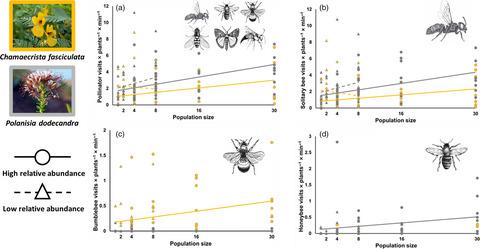Our official English website, www.x-mol.net, welcomes your
feedback! (Note: you will need to create a separate account there.)
Population‐ and community‐level rarity have opposing effects on pollinator visitation and seed set
Journal of Ecology ( IF 5.3 ) Pub Date : 2020-03-20 , DOI: 10.1111/1365-2745.13390 Kaitlyn S. Brown 1 , Benjamin Gilbert 1
中文翻译:

人口和社区一级的稀有性对传粉媒介的访视和结实有相反的影响
更新日期:2020-03-20
Journal of Ecology ( IF 5.3 ) Pub Date : 2020-03-20 , DOI: 10.1111/1365-2745.13390 Kaitlyn S. Brown 1 , Benjamin Gilbert 1
Affiliation

|
- When can small, isolated populations overcome the negative consequences of rarity? Despite considerable effort to understand threats to rare species, few studies consider how community context alters these threats. Plant–pollinator interactions offer the opportunity to test the effect of community context on rare species success, as plant–pollinator dynamics are thought to be influenced by neighbouring plants, both through competition for pollinators (reducing success in small populations) and attraction of potential pollinators (increasing success in small populations). Here, we test these predictions by experimentally decoupling community‐level rarity (relative abundance) from population‐level rarity (population size) in experimental two‐species fragments.
- We created experimental plant communities varying independently in population rarity (population size) and community rarity (relative abundance) of two annual plant species. We isolated plant roots to eliminate resource competition. We then compared the effects of population size versus relative abundance on pollinator visitation rates and an estimate of seed production.
- Both species had greatest pollinator visitation in large populations, but the negative effects of population rarity on visitation were partially offset when the neighbouring species was more abundant—community rarity offset the impacts of population rarity for the most common group of pollinators, solitary bees. These visitation trends impacted seed production for one species. When at low relative abundance, Polanisia dodecandra had higher seed set, matching increased visitation by solitary bees. Chamaecrista fasciculata showed no change in seed production with population‐ or community‐level rarity.
- Synthesis. Our results suggest that the surrounding community can offset the negative effects of low absolute abundance on fitness when neighbouring species are more abundant, and may ultimately maintain diversity even in fragmented ecological communities.
中文翻译:

人口和社区一级的稀有性对传粉媒介的访视和结实有相反的影响
- 少数孤立的人口何时能够克服稀有性的负面影响?尽管人们为了解稀有物种的威胁付出了巨大的努力,但很少有研究考虑社区环境如何改变这些威胁。植物-授粉媒介的相互作用提供了机会来测试社区环境对稀有物种成功的影响,因为植物-授粉媒介的动态被认为受相邻植物的影响,包括通过竞争授粉媒介(减少小种群成功)和吸引潜在授粉媒介(在少数人群中提高成功率)。在这里,我们通过实验性的两个物种片段中的社区水平的稀有度(相对丰度)与人口水平的稀有度(人口规模)脱钩,来检验这些预测。
- 我们创建了实验植物群落,它们在两个年度植物物种的种群稀有度(种群大小)和群落稀有度(相对丰度)方面独立地变化。我们隔离了植物的根源以消除资源竞争。然后,我们比较了种群数量与相对丰度对传粉媒介访视率和种子产量估算的影响。
- 这两个物种在大种群中都有最大的传粉媒介探访,但当邻近物种更丰富时,种群稀有度对探访的负面影响被部分抵消了—社区稀有度抵消了最常见的授粉媒介群(孤蜂)的种群稀有度的影响。这些访问趋势影响了一个物种的种子生产。当低相对丰度时,十二生菜具有较高的结实率,与单蜂的访视增加相匹配。Chamaecrista fasciculata的种子产量没有发生变化,但种群或社区水平稀有。
- 合成。我们的结果表明,当邻近物种更丰富时,周围社区可以抵消绝对绝对值低对健身的负面影响,甚至在零散的生态社区中也可能最终保持多样性。











































 京公网安备 11010802027423号
京公网安备 11010802027423号